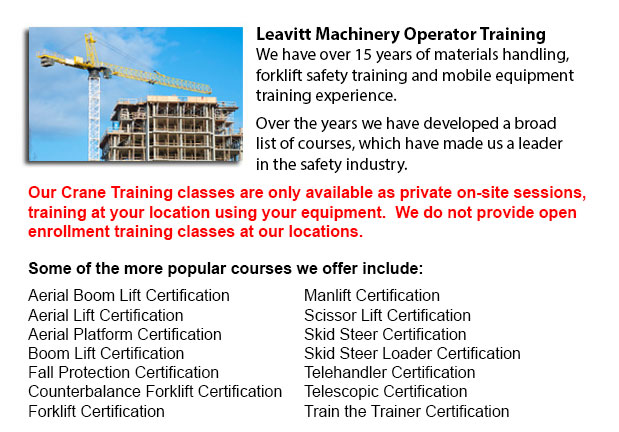
Oshawa Overhead Crane Safety Training - The overhead crane safety training program is meant to equip the operators with the right skills and knowledge in the areas of: crane safety precautions, accident avoidance, materials handling, and equipment and stock protection. Each of the trainees will get to learn on many kinds of overhead cranes, their capabilities and their uses in different settings. For operators who are licensed and trained, the shift in liability moves to the operator from the company. Hence, the program emphasizes individual operator responsibilities.
The operators in the overhead safety training program would be given instruction on the correct techniques for carrying out inspections: the more detailed in-depth inspection and the pre-shift inspection. These are vital every day routines that should be logged. Correctly recorded pre-shift checks help to protect the company from liability in the event of an accident. Pre-shift checks likewise prevent costly repairs, accidents and damage. Operators learn how to designate a specific individual to carry out checks, how to maintain the log book and how to report problems.
Checks should be carried out often and documented properly. The following should inspected while watching for usual problems: increase in the throat opening, hooks for cracks, hoist ropes for corrosion, degree of twist, worn wires, loss of diameter, broken wires, bird caging and kinks, chains for gouges and nicks, heat and chemical damage, corrosion and cracks, twists, excessive wear, distortion, pits, stretching, damage caused by extreme heat.
Operators learn proper rigging methods in this course. Rigging includes understanding the manufacturer's data plate, determining the material weight to be lifted, selecting the gear, and using safe practices to secure the load. The program include in detail the following: safe working loads, and the capacities of chains, ropes, shackles, slings and hooks.
It is important to know who may operate the cranes at your facility, the job's physical requirements, and operator credentials required for specialized job and permits. Safety is a priority when utilizing in the vicinity of pedestrian traffic.
Safe crane use consists of duties such as checking for hydraulic leaks, undertaking visual inspections, testing the controls, checking the safety guards, examining the hook and hoist rope, limit switches and braking mechanisms. Proper reporting methods are vital. These topics are all covered in depth in the course.
Proper lifting and moving methods with hoists and cranes are included in the course. Operators will become competent in hand signals. Training includes how to attach the load, raise the load, abort a lift, set the load and unhook the slings.
The steps included with moving the load, consists of: stopping and starting procedures, controlling and guiding the load, observing working conditions and working with signals. In the event of power failures, the operator would need to know how to proceed. The program covers techniques for removing the slings and lowering the load, storage of equipment, parking the crane, and securing an outdoor and indoor crane.
-
Oshawa Scissor Lift Operator Certification
Oshawa Scissor Lift Operator Certification - North American regulators recommend that worksites need operators of scissor lifts, booms or aerial work platforms to obtain certification training. Scissor lift operator certification is not mandatory, bu... More -
Narrow Aisle Forklift / Order Picker Training / Electric Pallet Jack / Electric Pallet Truck Training in Oshawa
A pallet lift is a model of equipment dedicated in the moving of pallets of many dimensions and weights. They might be utilized as an appendage for platform lifts, cranes and other types of heavy machinery or be applied on their own. Pallet hoists ar... More -
Oshawa Crane Operator Certification
Oshawa Crane Operator Certification - The process to permit people to be able to operate certain kinds of cranes is to take crane operator certification training to get certification. The certification process incorporates classroom learning, hands-o... More -
Oshawa Aerial Platform Training
Oshawa Aerial Platform Training - Aerial platform lifts might be utilized to accomplish a lot of unique tasks executed in hard to reach aerial places. A few of the odd jobs associated with this style of lift include performing routine repair on build... More -
Oshawa Forklift Certification Schools
Oshawa Forklift Certification Schools - Forklift Certification is mandatory within North America. Hence, forklift training programs are important both for companies and for people seeking jobs in industries as forklift operators. Forklift training fo... More -
Oshawa Heavy Equipment Ticket
Oshawa Heavy Equipment Ticket - Depending on the nature of the job at hand, the type of construction equipment that a heavy equipment operator makes use of varies. Each and every type of machine is built to perform specific jobs in the most effective... More -
Oshawa Heavy Equipment Certification
Oshawa Heavy Equipment Certification - Large pieces of machines and heavy-duty vehicles are usually known as heavy equipment. This broad term includes utility vehicles from forestry and agricultural implements to civil engineering vehicles, construct... More -
Oshawa Manlift Training
Oshawa Manlift Training - Various manlift training programs include the review and content of manlift devices. An essential portion of the program is the practicum where students demonstrate their knowledge and practical ability to safely operate a m... More

Forklift Certification Oshawa
TOLL FREE: 1-888-254-6157
Oshawa, Ontario
forkliftcertificationoshawa.com
Email Us
About Us


